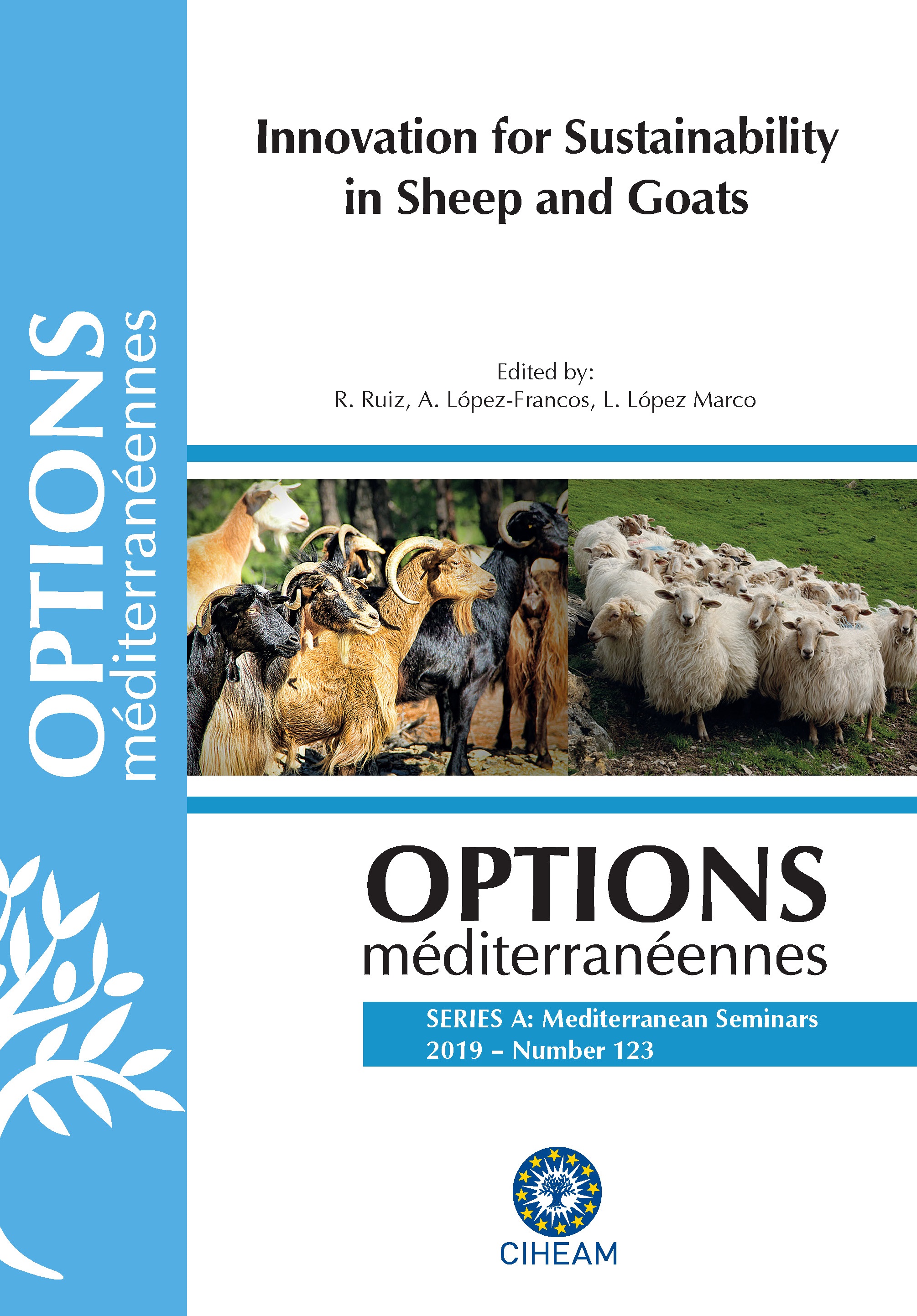| Article précédent | p. 235-239 | Article suivant |
Performances of Barbarine ewes grazing on wheat stubble under conventional and conservation agricultural conditions in a Tunisian semi-arid area
The aim of this work was to study the effect of agricultural practices (Conventional and conservation agriculture: Conv.A and CA respectively) on live weight variation and body condition scoring (BCS) of Barbarine ewes in Tunisian semi-arid conditions. The trial was carried out in the experimental station of INRAT (Region of Zaghouan) in two plots of bread wheat stubble, cultivated respectively according to Conv. A and CA conditions. Each one was dividedinto 3 electrically fenced subplots and each subplot had an area of 1665 m2 for a stocking rate of 30 ewes/ha.Thirty Barbarine breed ewes (Initial average weight 38 ± 1.86 kg) were divided into 6 homogeneous groups of 5 ewes each (3 groups for each agricultural system: Conv.A and CA). Animals grazed during a period of 45 days. Live Weight (LW), Daily Live Weight Gain (DLWG) were determined 4 times after the start of the experiment (every 10 days) and BCS was determined at the beginning of the experiment and 40 days after. Results showed that Live Weight increased significantly from the first weighing time until the end of the experiment both in Conv. A and CA (P<0.05, + 3.94 and 3.85 kg respectively). In the second period, DLWG decreased significantly in CA plot (P<0.05, -40.1 g/d), affecting the body weight which decreased but not significantly. Then, the live weight increased in the third period and it was maintained until the end of the experiment with a positive DLWG registered on ewes. The same trends of variation in LW were found in Conv.A and CA. For all the weighing times, no differences in LW and DLWG values between agricultural practices were noted. Results relative to BCS variation showed that no significant differences were observed in lumbar region score between the two investigated agricultural practices in the 2 measurement periods. The variation of tail region score according to agricultural practices at the start and the end of experiment showed that both in Conv. A and CA, the tail region score increased significantly (P<0.01; P<0.0001, respectively for Conv. A and CA).Statistically, the two investigated agricultural practices (Conv.A and CA) didn’t affect the tail region score whatever the measurement time. It was concluded that in these experimental conditions, no differences were found in performances between the two agricultural practices.
L’objectif de ce travail était d’étudier l’effet des pratiques agricoles (Agriculture conventionnelle et agriculture de conservation : Conv.A et CA respectivement) sur la variation du poids vif(PV) et la note d’état corporel (NEC) des brebis de race Barbarine dans les conditions semi-arides tunisiennes. L’essai a été mené dans la station expérimentale de l’INRAT (Région de Zaghouan) dans deux parcelles de chaume de blé, cultivées respectivement selon l’agriculture conventionnelle et l’agriculture de conservation. Chaque parcelle était divisée en 3 sous-parcelles électriquement clôturées ayant chacune une superficie de 1665 m2 pour une charge de 30 brebis / ha. Trente brebis de race Barbarine (Poids Moyen Initial 38 ± 1,86 kg) ont été réparties en 6 groupes homogènes de 5 brebis chacun (3 groupes pour chaque système agricole: Conv.A et CA). Les animaux ont pâturé pendant 45 jours. Le poids vif (PV) et le Gain Moyen Quotidien (GMQ) ont été déterminés 4 fois après le début de l’expérience (tous les 10 jours) et la NEC a été déterminée au début de l’expérience et 40 jours après. Les résultats ont montré que le poids a augmenté significativement dés le début jusqu’à la fin de l’expérience à la fois dans Conv. A et CA (P <0,05, + 3,94 et 3,85 kg respectivement). Au cours de la deuxième période, le GMQ a diminué de manière significative dans CA (P <0,05, -40,1 g / j), affectant le poids corporel qui a diminué mais non significativement. Ensuite, le poids vif a augmenté dans la troisième période et il a été maintenu jusqu’à la fin de l’expérience avec un GMQ positif enregistré chez les brebis. Les mêmes tendances de variation du poids vif ont été signalées dans les deux types d’agriculture. Pour tous les temps de pesée, aucune différence du PV et du GMQ n’a été enregistrée entre les pratiques agricoles. Les résultats relatifs à la NEC n’ont mentionné aucune différence significative dans le score de la région lombaire entre les deux types d’agriculture dans les deux périodes de mesure. Le score de la région caudale dans Conv.A et CA au début et à la fin de l’expérience a augmenté de façon significative (P <0,01; P <0,0001, respectivement pour Conv. A et CA). Statistiquement, les deux types d’agriculture étudiés (Conv.A et CA) n’ont pas affecté le score de la région caudale quel que soit le temps de mesure. On a conclu que, dans ces conditions expérimentales, aucune différence n’a été enregistrée quant aux performances entre les deux pratiques agricoles.
- [ Afficher ]
- [ Télécharger ]
- [ Exporter la citation ]
Vous pouvez télécharger la citation au format :
- [ Imprimer ]
-
Mots-clés
BREBIS, PATURAGE, PERFORMANCE, AGRICULTURE DE CONSERVATIONCiter cet article
Guesmi H., Moujahed N., Ben Youssef S., Darej C., Chakroun M., Ben Salem H. Performances of Barbarine ewes grazing on wheat stubble under conventional and conservation agricultural conditions in a Tunisian semi-arid area. In : Ruiz R. (ed.), López-Francos A. (ed.), López Marco L. (ed.). Innovation for sustainability in sheep and goats. Zaragoza : CIHEAM, 2019. p. 235-239. (Options Méditerranéennes : Série A. Séminaires Méditerranéens; n. 123). 2. Joint Seminar of the Subnetworks on Nutrition and on Production Systems of the FAO-CIHEAM Network for Research and Development in Sheep and Goats, 2017/10/03-05, Vitoria-Gasteiz (Spain). http://om.ciheam.org/om/pdf/a123/00007891.pdf



